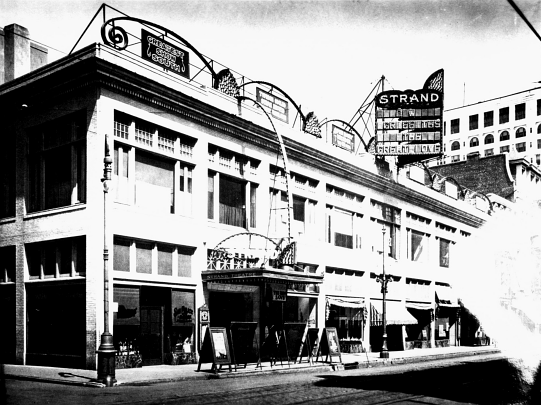|
|
||||
|
|
||||
| Strand Theatre New Orleans, Louisiana |
229 Baronne Street, corner of Baronne & Gravier streets, New Orleans |
|||
|
|
||||
|
|
||||
|
|
||||
|
|
||||
| Strand Theatre New Orleans, Louisiana |
229 Baronne Street, corner of Baronne & Gravier streets, New Orleans |
|||
|
|
||||
|
|
||||

The Strand is running D. W. Griffith's The Great Love, about 1918.
New Orleans' first movie palace.
Built & operated by the Saenger organization, the Strand Theatre was the company's premier New Orleans house until the opening of the New Orleans Saenger Theatre ten years later.
|
The construction & opening of the Strand Theatre in New Orleans was a landmark indicating that the Saenger company moving up from Shreveport was doing things in a big way, but it also represented a change in the way people went to the movies. Movies had been growing more popular as a cultural phenomenon, but the theatres & movie-going habits had not yet been established as solid cultural norms. Movies had started as novelties shown in variety theatres, fading interest then left them to be shown in nickelodeons and as "audience chasers" in vaudeville houses, then finally growing up a bit being shown in smaller storefront theatres dedicated to showing movies alone. "Going to the movies" was something a lot of people did, but it wasn't yet something most middle-class folks didn't feel a little self-conscious about when they occasionally did it. There was some pressure to make that change due to improvements in the movies themselves: technically they were fast improving from primitive novelties to entertainments with more advanced entertainment insight & effectiveness. Artists working in the movies became better and more popular entertainers themselves. Douglas Fairbanks, Mary Pickford, Charles Chaplin, D. W. Griffith & others were producing worthwhile entertainments with popular favor enough to drive folks to see their work, & then go back to see their work again. It all turned the corner with changing the theatres from small places that just met the minimum technical requirement to comfortably seat an audience & present a film to places that had more cultural value & just a little snob appeal: important civic buildings, dispensaries of cultural knowledge, clean, not just socially acceptable but attractive destinations in themselves. The person most associated with transforming movie theatres in this way was S. L. Rothapfel, nicknamed "Roxy". His work creating very successful movie theatres via emphasizing in publicity & practice not just quality but higher-class environmental aspects such as palatial architecture, uniformed staff, large orchestras, & broader programs made popular successes of the the New York Regent in 1913, the New York Strand in 1914, then the New York Rialto in 1916: escalating in size, seriousness, & cultural value. What was obvious in the motion picture exhibition industry was that Rothapfel was figuring out how to make it work. What was obvious to the customers was beautiful theatres with rich programs that made it worthwhile to attend often. The Saenger company already owned & operated several movie theatres in New Orleans, & had to keep up with the game. So when they opened their very large 2,000 seat movie palace the Strand in New Orleans, following the Rothapfel model of larger theatres with high quality attendant features, they went all the way & "invited" S. L. Rothapfel to come to the opening of the theatre to produce the opening night program (& use his name for some even bigger-city high-class validation of the theatre to the customers). This was a new way to see a movie. It was no longer ducking into a storefront theatre to watch the flickers accompanied at best by a couple of musicians; it was a major entertainment program. The opening night program was: an overture from the 35-piece orchestra, then orchestral & organ accompaniment of a newsreel, comedy short, color travelogue-type short, & a feature film with Douglas Fairbanks, "Wild & Woolly". Louisiana governor Ruffin Pleasant & New Orleans' mayor Martin Behrman had seats in the loges; & Behrman even spoke a few words at the opening. The Strand had a Wurlitzer Style 4 organ (2 manuals, 8 ranks, 5PR 10TS Cathedral Chimes) in use from its 1917 opening; the Strand's organist was "Professor Fitch". It's a theatre organ that technically seems small today, but it was an average size for theatre organs in its time & another statement of advancing movie theatre equipment & culture considering that the Rialto in New York still had a fairly straight organ. The Wurlitzer was later replaced with a 3 manual, 8 rank Robert Morton organ which may have been enlarged later to 10 ranks. Organist Rosa Rio played here; Ray McNamara later became the Strand's house organist after leaving the post of associate organist at the New Orleans Saenger Theatre. In 1937, the Strand was leased to southeastern movie theatre magnate Joy Houck, who operated it for a while as the Joy Strand theatre. Joy Houck later remodeled the theatre, outfitted it with 70mm projectors & an enormous curved screen, renamed it the Panorama, & it became New Orleans' Todd-AO house. |
Thanks to Barry Henry for photos & information
Copyright © 1999 - 2009, William Hooper.
| Back to the Saenger Theatres | Next: the Tivoli Theatre in New Orleans, Louisiana |